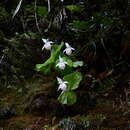Biology
provided by Arkive
The peculiar pouch and staminode that characterise the slipper orchids are central elements to a cunning pollination strategy for this plant (5) (6). Firstly, the fragrance of the flower or the colouration of the staminode (or a combination of the two) attracts would be pollinators, such as bees and flies. However, the shield-like staminode prevents the insects from directly accessing the flower, and frustrated individuals often fall into the pouch below. The only escape from the slippery-sided pouch is to ascend a ladder of hairs, through the column and out the base of the flower, bringing the insects into contact with the stigma and the anthers in the process (5). The newly-escaped insects inevitably end up falling foul of the same ruse, and in doing so, transfer pollen from one flower to the stigma of another (4) (5) (6).
In common with all orchids, the seeds of slipper orchids are microscopic and lack food reserves. As a consequence, they are dependant on a symbiotic relationship with a fungus which provides the initial nutrient reserves for the seeds to germinate, and thus will only grow where the fungus is present (5).
Conservation
provided by Arkive
Fortunately, Cypripedium formosanum is one of the easiest slipper orchids to grow from seed and is frequently seen in cultivation (2). As a result, even though it is only protected on Appendix II of the Convention on International Trade in Endangered Species (CITES), which technically allows wild specimens and artificially propagated specimens to be traded under a permit, there is unlikely to be a significant demand for trade in wild plants (3) (7). Nonetheless, in common with most Cypripediums, very little is known about its population trends and status in the wild. This information is crucial to accurately establish how threatened the remaining wild population is, and to enable the formation and implementation of conservation measures as necessary (2).
Description
provided by Arkive
The slipper orchids, which comprise around 150 species from five genera, are easily distinguished from other orchids by the slipper-like pouch formed by the lower petal (2) (4) (5). Furthermore, unlike 99 percent of orchids, which have only one fertile stamen, the slipper orchids have two, which fuse to form a column with the style and a sterile central stamen, curiously shaped like a shield, called the staminode (4) (5) (6). The showy flowers of Cypripedium formosanum are one to a stem and flushed pink with white and crimson spots and blotches (2). The leaves grow from the base and are oval shaped and pleated with prominent veins (7).
Habitat
provided by Arkive
This endangered slipper orchid occurs in forests and open damp areas in montane habitat between 2,000 and 3,000 metres above sea-level (2).
Range
provided by Arkive
Cypripedium formosanum is endemic to the high mountains of Taiwan (2).
Status
provided by Arkive
Classified as Endangered (EN) on the IUCN Red List (1) and listed on Appendix II of CITES (3).
Threats
provided by Arkive
Despite such an elaborate pollination strategy, the actual reproductive success rate of slipper orchids is astoundingly low, with only a small fraction of flowers ever producing seed (6). Considering the seeds that do develop are then dependant on a finely balanced relationship with a fungal partner, it is no surprise that slipper orchids are vulnerable to poor regeneration, particularly when disturbance is high (5). It does not help that because of their unusual and attractive flowers, slipper orchids are highly sought after by collectors and horticulturalists (5) (6). In particular, Cypripedium formosanum is considered by many to be the most beautiful species in the genus (2).
Cypripedium formosanum
provided by wikipedia EN
The Formosan lady's slipper or beautiful cypripedium, Cypripedium formosanum, is a species of orchid endemic to Taiwan.[2][3]
This species is restricted to the central mountains of Taiwan, where it grows in several types of habitat in mountain forests and bogs. It is associated with species of ferns, Epimedium, Trillium, and Podophyllum, and Diphylleia grayi. It is also cultivated, being attractive and easy to grow and propagate.[1]
References

- license
- cc-by-sa-3.0
- copyright
- Wikipedia authors and editors
Cypripedium formosanum: Brief Summary
provided by wikipedia EN
The Formosan lady's slipper or beautiful cypripedium, Cypripedium formosanum, is a species of orchid endemic to Taiwan.
This species is restricted to the central mountains of Taiwan, where it grows in several types of habitat in mountain forests and bogs. It is associated with species of ferns, Epimedium, Trillium, and Podophyllum, and Diphylleia grayi. It is also cultivated, being attractive and easy to grow and propagate.
- license
- cc-by-sa-3.0
- copyright
- Wikipedia authors and editors

